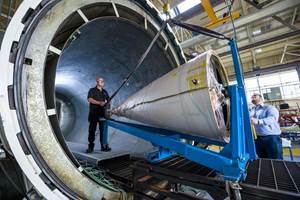Army partners with Lockheed Martin to develop new materials for defense applications
The Army Research Laboratory and Lockheed Martin Corp. are partnering to create new materials for defense optical technology and protective coatings.
The U.S. Army Combat Capabilities Development Command’s Army Research Laboratory (ARL, Adelphi, Md., U.S.) and the Lockheed Martin Corp. (Bethesda, Md., U.S.) have announced a five-year cooperative agreement, titled “Self-Assembly of Nanostructures for Tunable Materials,” to enhance devices and technology used by warfighters.
Under the agreement, ARL and Lockheed Martin will develop rapid prototyping methods using bio-production and self-assembly to create the building blocks of novel materials for defense optical technology and protective coatings.
The research is intended to advance Army goals for the use of biological systems for on-demand synthesis of materials and embedding biological products into materials for advanced specialty paints for corrosion and protection, light weight, high performance optics for sensing on drones and production and repair of parts and systems for expeditionary forces through simpler, greener and rapid adaptation.
According to ARL, the collaborative effort leverages a current tri-service synthetic biology Department of Defense Applied Research for Advancement of Priorities program, the Army's Institute for Collaborative Biotechnologies and the Army's Open Campus framework to co-locate academic, Army and industrial personnel in regional technology hubs of Boston, Mass., and Austin, Texas. The collaboration envisioned in this proposed effort will be wide-ranging, and will involve personnel, material, data, models and method exchanges.
According to Dr. James Sumner, branch chief of ARL's Biotechnology branch, the capabilities developed under this research program have potential application across the civilian market as well, to include green manufacturing of materials such as production of toxic-free paint with anti-fungal/anti-mold protection, and biomedical applications such as reducing the size, weight and cost of diagnostic and surgical devices.
"In addition, the functional coatings work proposed in the agreement for electro-optic and electromagnetic technology has potential impact on conformal antenna work in automotive, aerospace and drone technology that is under development for security, product delivery and other applications," Sumner says. "The advances in controlled assembly could open up the market for the emerging field of autonomously assembled polymers and composites."
According to Dr. Dimitra Stratis-Cullum, ARL research chemist and an Essential Research Program manager, the commitment to invest in synthetic biology in the Army and Department of Defense (DOD) along with ARL's Open Campus business model propelled the collaboration. “ARL made a strategic decision to invest in synthetic biology beginning in fiscal year 2019,” Stratis-Cullum says. “Soon after, the Office of the Secretary of Defense established a tri-service DOD Applied Research for Advancement of Priorities program titled ‘Synthetic Biology for Military Environments.’ The collaborative effort with Lockheed Martin came about from conversations, reviews and workshops revolving around our strategic growth and collective interest in this area to ultimately make a game-changing impact on the Army and the soldier.”
"The convergence of synthetic biology and materials science aims to accelerate the discovery to product pipeline to meet emerging needs in multi-domain operations including smaller, cheaper and agile production of high performance optics and protective coatings," Stratis-Cullum says. "This will drive to add advanced capabilities onto lower cost platforms. The rapid and agile development time will allow us to adapt to pacing threats and the simpler low-energy production methods could open up new capabilities to support expeditionary forces, repair of complex materials and systems and forward support to sustainment."
"ARL is bridging to the academic community through co-located personnel as well as integrated and collaborative research across biology, materials science, chemistry and engineering disciplines," Stratis-Cullum said. "ARL is providing the synthetic biology expertise, facilities needed to gain an understanding of biological assembly through combined efforts in genetic control, material-based screening and modeling. Lockheed Martin is bringing design and experience in manufacturing and systems expertise through interdisciplinary scientists across their many business units. It's bringing all this together in an integrated and iterative fashion that we believe will accelerate bringing synthetic biology solutions to the Soldier."
Both ARL and Lockheed Martin have several research laboratory locations and personnel and facilities in the Boston and Washington, D.C., metropolitan regions to include ARL Northeast, which will aid in the collaborative exchange.The researchers anticipate this generating a translational pipeline with tools to bridge the gap into functional materials that will open up the aperture on a variety of military concepts.
"We are linking some of the brightest minds across the country from government, academia and industry to ensure the most integrated, agile approach to solving some of the Army's most pressing challenges,” says Dr. Melissa Flagg, regional lead for ARL Northeast. “ARL Northeast taps one of the most significant intellectual ecosystems in the world and brings access to a unique expertise and creativity at the intersection of biotechnology and materials science. We are excited about the opportunity to support this forward-leaning collaboration to not only extend our scientific knowledge, but to deliver state-of-the-art capabilities to the warfighter."
Initial efforts of this agreement are focused on understanding materials integration challenges with a focus on early wins in protective coatings. ARL and Lockheed Martin will be working closely with both DOD and commercial company partners that align with DOD's Engineered Resilient Systems, Materials and Manufacturing Processes, as well as Army and DOD science and technology ecosystem for early adoption of synthetic biology products.
Officials are planning a formal program launch to be held later this year.
Related Content
Industrializing additive manufacturing in the defense/aerospace sector
GA-ASI demonstrates a path forward for the use of additive technologies for composite tooling, flight-qualified parts.
Read MoreUS Air Force selects Integris Composites ballistic body armor
Cratus Wave armor is thin, lightweight and reduces heat stress, providing buoyant personal protection for the 582nd Helicopter Group.
Read MoreParker Hannifin completes acquisition of Meggitt PLC
With the acquisition, Parker Aerospace Group aims to expand its portfolio with Meggitt’s global defense and aerospace technologies.
Read MoreHigh-performance, high-detail continuous 3D-printed carbon fiber parts
Since 2014, Mantis Composites has built its customer and R&D capabilities specifically toward design, printing and postprocessing of highly engineered aerospace and defense parts.
Read MoreRead Next
From the CW Archives: The tale of the thermoplastic cryotank
In 2006, guest columnist Bob Hartunian related the story of his efforts two decades prior, while at McDonnell Douglas, to develop a thermoplastic composite crytank for hydrogen storage. He learned a lot of lessons.
Read MoreCW’s 2024 Top Shops survey offers new approach to benchmarking
Respondents that complete the survey by April 30, 2024, have the chance to be recognized as an honoree.
Read MoreComposites end markets: Energy (2024)
Composites are used widely in oil/gas, wind and other renewable energy applications. Despite market challenges, growth potential and innovation for composites continue.
Read More
.jpg;width=70;height=70;mode=crop)

















.jpg;maxWidth=300;quality=90)







